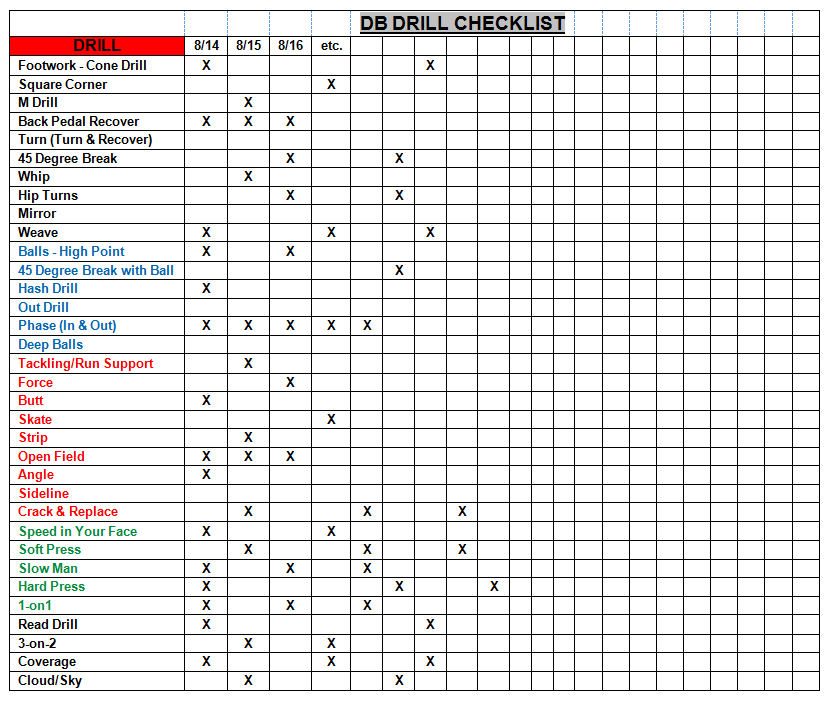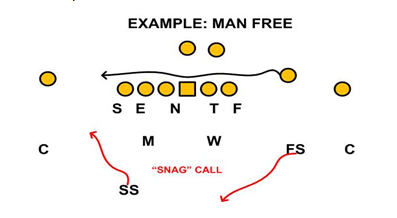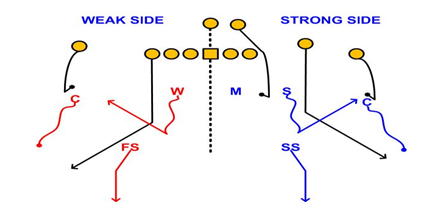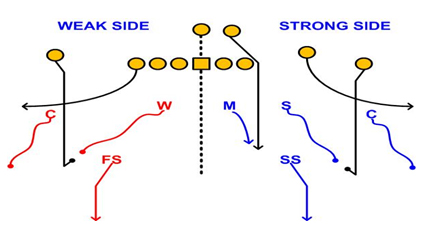| Cardinal Defensive Back Teaching Progression
I can't emphasize it enough that we are teachers. That is the essence of coaching. It is very important to establish great relationships with your players. It is the job of the coach to get the very best out of their players both on and off the field. I have developed a series of checklists that help me in making certain that we stay on track with what we are teaching. There are things that we do on a daily basis and other things that are not as important, but must be done periodically. These checklists help us keep track of what we have done and show us the things that we need to do more. Below is our drill checklist. It is charted on a daily basis and paints a great picture of what drills we are using and what drills need more repetition.
|
 |
| The following is our Daily DB Checklist and teaching progression: |
 |
|
We start every meeting with a review and video of practice. We use a chair drill or simulated walk-through to make calls and adjustments. This gets the players actively involved in what is being taught. I will put formations on the board and have a group of DBs stand and get aligned. They will make their calls and adjustments to formations based on the call that I give them. This has been a great teaching tool. It breaks up the monotony of a long meeting. Keep it positive! Keep their attention! |
 |
| The next thing in the teaching progression is practice. It is broken down into individual, group and team periods.
Individual — This is the most important part of practice. This is where fundamentals are drilled. Footwork and ball drills, block protections and tackle drills are done on a daily basis. We must be good at the above because they are the foundation of what we do. We will use wide receivers in our individual drills when they are available. Real speed helps you get better. Group — An example of group is our half-line pass drill. It is something that we do as much as possible to teach coverages. We try to get as many reps in this drill as possible, but will slow it down to teach. We will only rep one coverage per day. Generally, it is a ten minute period. We will work one side at a time – strong side, then weak side. We will rep basic pass concepts vs. the coverage called. Below is an example of this vs. Cover 2: |
 |
| Remember rep is half-line – strong side first and repeat it weak side. |
 |
| Another drill that is done on a daily basis is our inside drill. It teaches proper alignment and proper run fits. This is done vs. the offense. Below is an example vs. our base defense: |
 |
| This is done vs. various formations and calls. It is a great drill because it teaches us how to support the run.
Pass skeleton (7-on-7) is another group drill we do vs. our offense and our scout team. When we do it vs. our offense, we emphasize technique vs. speed. Against our scout team, the emphasis is on formation recognition and routes. It is very important to do this drill in the field and in the Red Zone. Team — Finally, we will put it all together in team vs. the scout team or vs. our offense. We will work various situations vs. our offense – like a first-down mix, Red Zone, 3rd downs or goal line. The progression starts with our meetings and progresses to practice where individual work is key as you go to group and team work. You will get the best results out of your players if you spend individual time with them post-practice. By doing so, they will come to understand how much their knowledge and individual progress is integral to the progress and success of the entire team. |
|
About the Author... |
|
|
| Larry Slade begins his third season as the secondary coach at the University of Louisville, but just finished his first year on Charlie Strong's staff.
Slade was the lone holdover from the 2009 Louisville staff after 10 seasons at the University of Tennessee in the defensive backfield and is known for turning out some of the nation's best secondary units. He worked his magic again in 2010, guiding safety Hakeem Smith to an outstanding first year. Smith was a second team All-BIG EAST selection, but was also tabbed the league's Rookie of the Year and earned numerous Freshman All-America honors. Despite a 5-7 record by the Volunteers in 2008, Slade was instrumental in leading one of the nation's top defensive units. The Volunteers were ranked fourth in the country in pass defense and tied for the third in the country in total defense. Slade, 58, coached All-America defensive back Eric Berry, who was recognized by five All-America outlets -- American Football Coaches Association, Walter Camp Football Foundation, Football Writers Association of America, Associated Press and Sporting News -- becoming the first Tennessee player to claim unanimous mention since offensive lineman Antone Davis in 1990. Slade's 2000 and 2001 secondary units, aided and abetted by the rest of the defense, established school season records with 64 and 72 passes broken up, respectively. It continued a pattern of success that Slade has enjoyed in his 36 years in the coaching profession. Before coming to Tennessee, Slade spent five seasons at Texas A&M from 1994-98. His 1997 unit allowed a nation's best three passing touchdowns. Prior to joining the staff at A&M, Slade spent two seasons at Maryland as the defensive coordinator from 1992-93. Slade also spent six seasons at Washington from 1986-91, which was highlighted by a national championship in 1991, during which the Huskies ranked first in NCAA statistics for pass efficiency defense. Slade also enjoyed stops at Southern Illinois (1984-85), Howard (1983), Richmond (1982) and his alma mater Shepherd (1973-81). Slade, a native of Pelham, N.C., who twice was named All-West Virginia while playing guard at Shepherd in the early 1970s. He was named Little All-America honorable mention in 1971 and later inducted into the Shepherd College Hall of Fame. He received his degree in biology with a minor in English. |


